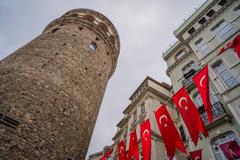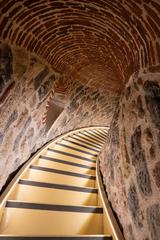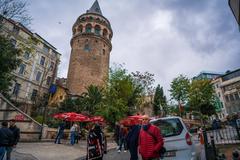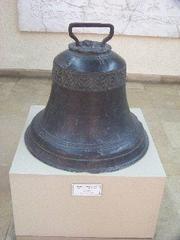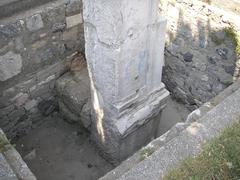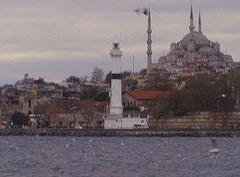
Comprehensive Guide to Visiting Galata Tower: History, Significance, Visitor Tips, and Everything Tourists Need to Know
Date: 15/07/2024
Introduction
The Galata Tower, or Galata Kulesi in Turkish, is one of Istanbul’s most iconic historical landmarks, embodying centuries of rich history and architectural splendor. Situated in the Galata district of Istanbul, this medieval stone tower offers not only breathtaking panoramic views but also a riveting historical narrative that attracts millions of visitors each year (Istanbul.tips). Originally constructed during the Byzantine period under Emperor Justinian in 507-508 AD, the tower was later rebuilt by the Genoese in 1348 as part of their fortification efforts in Constantinople. Over the centuries, its role has evolved—from a watchtower and prison to a fire watchtower during the Ottoman era, and finally, a modern museum and observation deck (Wikipedia). The Galata Tower stands at 67 meters (approximately 220 feet) and its robust cylindrical structure made of brick and ashlar masonry reflects a blend of Genoese and Byzantine architectural styles (Galata Tower). Recognized for its historical and cultural significance, the tower was included in the UNESCO tentative list of World Heritage Sites in 2013 (Arts and Culture). This guide aims to provide comprehensive information about visiting the Galata Tower, including its history, significance, visitor tips, and everything tourists need to know for an unforgettable experience.
Table of Contents
- Introduction
- Origins and Early Construction
- Genoese Influence and Reconstruction
- Ottoman Era Transformations
- Architectural Significance
- Restoration and Modern Use
- Visiting Hours and Tickets
- Travel Tips
- Cultural and Historical Impact
- Special Events and Photography Spots
- Legends and Myths
- UNESCO World Heritage Status
- FAQ
- Conclusion
- References
Origins and Early Construction
The origins of the Galata Tower date back to the Byzantine period when Emperor Justinian constructed a tower in the area around 507-508 AD. This initial structure served primarily as a watchtower to oversee the surrounding region (Istanbul.tips).
Genoese Influence and Reconstruction
The current structure of the Galata Tower was built by the Genoese in 1348 during their expansion in the Galata district. Named the Christea Turris, or Tower of Christ, it was part of their fortification efforts to protect their colony in Constantinople. The tower was constructed in the Romanesque style, characterized by robust stone walls and a conical roof (Wikipedia).
Ottoman Era Transformations
After the Ottomans conquered Constantinople in 1453, the Galata Tower underwent significant changes. It was repurposed multiple times, initially serving as a prison for war captives and later as a fire watchtower due to its strategic height and location. The tower’s role as a fire watchtower was crucial in a city prone to frequent fires (History Tools).
Architectural Significance
Standing at 67 meters (approximately 220 feet), the Galata Tower offers panoramic views of Istanbul and the Bosphorus Strait. Its cylindrical structure, made of a combination of brick and ashlar masonry, reflects a blend of Genoese and Byzantine architectural styles. The conical roof adds to its medieval charm, making it a distinctive landmark in Istanbul (Galata Tower).
Restoration and Modern Use
The tower has undergone several restorations over the centuries, particularly after suffering damage from earthquakes and fires. A significant restoration occurred between 1965 and 1967, which aimed to preserve its historical integrity while making it accessible to the public. During this restoration, the tower was converted into a museum and observation deck, offering visitors a glimpse into its historical and architectural significance (Arts and Culture).
Visiting Hours and Tickets
The Galata Tower is open to visitors daily. The visiting hours are typically from 9:00 AM to 7:00 PM, but it is advisable to check the official website for any changes. Ticket prices are generally around 35 Turkish Lira for adults, with discounts available for children and seniors. Tickets can be purchased online or at the entrance.
Travel Tips
- Best Time to Visit: Early morning or late afternoon to avoid crowds and enjoy the best lighting for photographs.
- Accessibility: The tower is equipped with an elevator, but there are still some stairs to climb to reach the observation deck.
- Nearby Attractions: Explore the surrounding Galata district, which features narrow streets, historic buildings, and vibrant cafes.
- Guided Tours: Consider joining a guided tour to gain deeper insights into the tower’s history and significance.
Cultural and Historical Impact
The Galata Tower has played various roles in Istanbul’s history, serving as a watchtower, prison, and fire watchtower. It has also been a symbol of the city’s resilience and adaptability. Its strategic location on the Galata hill has made it a focal point for defense and observation throughout its history. Today, it stands as a testament to Istanbul’s rich cultural heritage and architectural prowess (Istanbul Joy).
Special Events and Photography Spots
The Galata Tower often hosts special events such as exhibitions and cultural performances. The tower and its surroundings also offer numerous spots for photography, providing stunning views of Istanbul’s skyline and the Bosphorus Strait.
Legends and Myths
One of the most famous legends associated with the Galata Tower is the story of Hezarfen Ahmed Çelebi, an Ottoman aviator who is said to have flown from the tower to the Asian side of Istanbul using artificial wings. This legendary flight, which supposedly took place in the 17th century, has become a part of Istanbul’s folklore, adding to the tower’s mystique and allure (Headout).
UNESCO World Heritage Status
In 2013, the Galata Tower was included in the UNESCO tentative list of World Heritage Sites, along with other Genoese towers in the Mediterranean and the Black Sea. This recognition highlights the tower’s historical and cultural significance, as well as its architectural uniqueness. The inclusion in the UNESCO list aims to ensure the preservation and protection of this iconic structure for future generations (Arts and Culture).
FAQ
- What are the visiting hours for Galata Tower? The tower is generally open from 9:00 AM to 7:00 PM daily.
- How much are tickets for Galata Tower? Tickets are typically around 35 Turkish Lira for adults, with discounts for children and seniors.
- Is the Galata Tower accessible? Yes, the tower is equipped with an elevator, but there are some stairs to reach the observation deck.
- What are some nearby attractions? The surrounding Galata district offers narrow streets, historic buildings, and vibrant cafes.
Conclusion
The Galata Tower’s history is a microcosm of Istanbul’s own evolution, reflecting the city’s diverse cultural influences and historical transformations. From its origins as a Byzantine watchtower to its current status as a UNESCO-recognized landmark, the tower stands as a symbol of Istanbul’s enduring legacy. Its architectural beauty, combined with its rich historical narrative, makes it a must-visit destination for anyone exploring the vibrant city of Istanbul. Don’t miss the chance to visit this iconic tower and immerse yourself in its fascinating history and panoramic views.
References
- Galata Tower - History, Visiting Hours, Tickets, and Travel Tips (Istanbul.tips)
- Galata Tower (Wikipedia)
- The Galata Tower: A Soaring Sentinel Over Istanbul’s Storied Past (History Tools)
- Architecture - Galata Tower (Galata Tower)
- Galata Tower (Arts and Culture)
- Visit the Galata Tower in Istanbul (Istanbul Joy)
- Galata Tower: Istanbul (Headout)
- Galata Tower: Plan your visit (Galata Tower)
- Experience Istanbul - Galata Tower (Istanbul Tourist Information)




